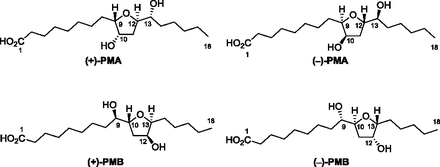Li, K.; Brant, C. O.; Huertas, M.; Hessler, E. J.; Mezei, G.; Scott, A. M.; Hoye, T. R.; Li, W. Proc. Natl. Acad. Sci. U.S.A. 2018, 115, 8603–8608.
Olfactory cues provide critical information for spatial orientation of fish, especially in the context of anadromous migrations. Born in freshwater, juveniles of anadromous fish descend to the ocean where they grow into adults before migrating back into freshwater to spawn. The reproductive migrants, therefore, are under selective pressures to locate streams optimal for offspring survival. Many anadromous fish use olfactory cues to orient toward suitable streams. However, no behaviorally active compounds have been identified as migratory cues. Extensive studies have shown that the migratory adult sea lampreys (Petromyzon marinus), a jawless fish, track a pheromone emitted by their stream-dwelling larvae, and, consequently, enter streams with abundant larvae. We fractionated extracts of larval sea lamprey washings with guidance from a bioassay that measures in-stream migratory behaviors of adults and identified four dihydroxylated tetrahydrofuran fatty acids, of which (+)-(2S,3S,5R)-tetrahydro-3-hydroxy-5-[(1R)-1-hydroxyhexyl]-2-furanoctanoic acid was shown as a migratory pheromone. The chemical structure was elucidated by spectroscopies and confirmed by chemical synthesis and X-ray crystallography. The four fatty acids were isomer-specific and enantiomer-specific in their olfactory and behavioral activities. A synthetic copy of the identified pheromone was a potent stimulant of the adult olfactory epithelium, and, at 5 × 10−13 M, replicated the extracts of larval washings in biasing adults into a tributary stream. Our results reveal a pheromone that bridges two distinct life stages and guides orientation over a large space that spans two different habitats. The identified molecule may be useful for control of the sea lamprey.
